Grimpoteuthis
Richard E. Young and Michael Vecchione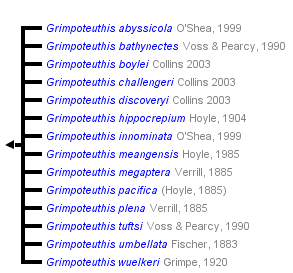


This tree diagram shows the relationships between several groups of organisms.
The root of the current tree connects the organisms featured in this tree to their containing group and the rest of the Tree of Life. The basal branching point in the tree represents the ancestor of the other groups in the tree. This ancestor diversified over time into several descendent subgroups, which are represented as internal nodes and terminal taxa to the right.

You can click on the root to travel down the Tree of Life all the way to the root of all Life, and you can click on the names of descendent subgroups to travel up the Tree of Life all the way to individual species.
For more information on ToL tree formatting, please see Interpreting the Tree or Classification. To learn more about phylogenetic trees, please visit our Phylogenetic Biology pages.
close boxIntroduction
Most species of Grimpoteuthis are poorly known. They are somewhat less compressed in the anterior-posterior axis than are members of Opisthoteuthis and they generally have relatively larger fins. Species are closely associated with the deep-ocean floor and some species, at least, alternate between sitting on the ocean bottom and swimming above it while some others apear to be completely pelagic.
Brief diagnosis:
An opisthoteuthid ...
- without enlarged sucker fields on arms of males.
- without areolae absent.
- with optic lobe circular in cross-section.
- with optic nerves passing through white body as a single bundle.
- with shell U-shaped or slightly W-shaped.
- with sucker aperture without tooth-like structures.
Full diagnosis of the genus (from Collins and Villanueva, 2006):
"Small-to-large grimpoteuthids with medium-to-large lateral fins, each with a distinct lobe near the anterior fin insertion. Shell vestige U-shaped; lateral sides parallel, not tapered to fine points. Radula monodont or absent. Posterior salivary glands small or absent. Web supported by single fleshy nodules on the ventral side of the arms. Digestive gland entire (single lobe). Sucker sexual dimorphism present in some species, but with single enlarged field."*
* Refers a diagnosis of the genus within their family Grimpoteuthidae which also includes the genera Cryptoteuthis and Luteuthis. They diagnose Grimpoteuthidae as follows, "Medium-to-large sized, bell-shaped cirrates with lateral fins. Web deep and simple. Shell U-shaped, with lateral walls parallel. Optic nerve passes though white body in single bundle. Radula reduced or absent. Posterior salivary glands reduced or absent. Cirri of short to moderate length. Gills of ‘half-orange’ form."
Characteristics
- Arms and web
- Suckers in males not greatly enlarged, not in two fields.
- Sucker aperatures without tooth-like structures (see Luteuthis for tooth-like structures).
- Cirrus length comparable to 2.5 times largest sucker diameter.
- Single web nodules present (arrow).
- Head
- Eyes: Large, diameter typically 1/3 of head width.
- Beaks: Descriptions of some species can be found here: Lower beak; upper beak.
- Pigmentation
- No areolar spots
- No areolar spots
- Fins
- Length approximately equals mantle width.
- Length approximately equals mantle width.
- Gills
- Semi-sepioid (in G. innominata) or half-orange appearance.
- Semi-sepioid (in G. innominata) or half-orange appearance.
- Digestive system
- Intestine approximately equal to esophagus (including crop) in length.
- Digestive tract arranged in simple U-shape.
- Digestive gland unilobular.
- Radula present or absent.
- Optic lobe and optic nerve bundles
- Optic lobe circular (rather than kidney-shaped) in cross-section.
- Single nerve bundle from optic lobe penetrates white body.
- Shell
- U-shaped, lateral walls of wings usually parallel to one another. Mid-saddle often with outer and inner surfaces convex but outer surface flat or concave in some species (eg, G. meangensis).
- Shoulders with or without shoulder blades.
Comments
The male reproductive tract shows considerable variation between species and is frequently described for new species. However the amount of variation within a species is unknown and therefore the specific value of the structures of the tract is uncertain. In addition there is some confusion regarding the identification of the various parts. Ebersbach (1915) made a careful dissection of the digestive tract of a Grimpoteuthis that he believed was G. umbellata. His illustration, relabeled, is shown on the right. The proximal glands on the sperm duct are often called "seminal vesicles." However, as Ebersbach pointed out, they are spermatophore-forming glands and should be called "spermatophore glands." A small gland (labeled "?") lies between the spermatophore and accessory glands that Ebersbach called the accessory spermatophore gland but may be Needham's sac.

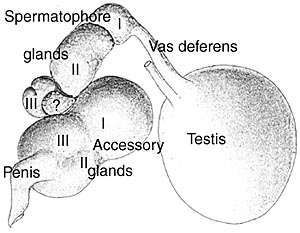
Figure. Male reproductive tract of Grimpoteuthis umbellata. Figure relabeled from Ebersbach (1915).
Species comparisons
| Species | No. arm suckers | Sucker no. at Arm I nodule | First cirrus between suckers | Length: cirrus/sucker; Male, female | Salivary glands | Gill lamellae | Eye size | Shell shoulder blades | Shell wings expanded | Shell saddle shape: Outer surface | Ocean |
| G. abyssicola | 77 | 32-34 | 4-6 | 2.5x | None | 8 | Large | No | Yes | Convex | South Pacific |
| G. bathynectes | 47-58 | 26 | 3-4 | 1.1x, 1.3x | Posterior | 7-9 | Large | No | No | Convex? | North Pacific |
| G. boylei | 55-58 | 31 | 4-7 | 1.9x, 2.2x | Ant., Post. | 7-8 | 1/3 HW | Weak | No | Depressed | North Atlantic |
| G. challengeri | 63-72 | 34 | 4-7 | 2.5x, 3.5x | Anterior | 7-8 | 1/3 HW | Yes | No | Convex | North Atlantic |
| G. discoveryi | 56-61 | 31 | 3-5 | 1.2x, 1.6x | Anterior | 6-8 | 1/3 HW | Weak | No | Convex | North Atlantic |
| G. hippocrepium | 50, | 25 | 4-5 | ? | ? | ? | ? | No | No | Flat? | E. tropical Pacific |
| G. innominata | 50-60 | 22-24 | 4-6 | 1x | None | 7 | large | Yes | Yes | Median ridge | South Pacific |
| G. meangensis | 60-70 | ? | 4-7 | ? | ? | ? | ? | Yes | ? | Flat | W. tropical Pacific |
| G. megaptera | ? | ? | ? | 2x | ? | ? | 1/3 HW | ? | ? | ? | North Atlantic |
| G. pacifica | 52 | ? | 6-8 | 2x | ? | ? | Large | ? | ? | ? | W. tropical Pacific |
| G. plena | 55 | ? | ? | 1.2-1.6 | ? | ? | small | ? | ? | ? | North Atlantic |
| G. tuftsi | 63-75 | ? | 5-7 | 1.5-3.5 | None | 7-8 | Large | Yes | No? | Transverse groove | North Pacific |
| G. umbellata | 65-68 | ? | 4-5 | 1.2x | ? | 8 | ? | ? | ? | ? | North Atlantic |
| G. wuelkeri | 60-70 | 28 | 4-7 | 2.5x, 1.2x | Ant., post. | 6-7 | 1/3 HW | Yes | No | Convex with ridge | North Atlantic |
Nomenclature
Robson (1932) erected the genus Grimpoteuthis to include some species formely placed in Cirroteuthis. He designated G. umbellata (Fischer, 1883) as the type species.
Behavior
Very little is known about the habits and behavior of species of Grimpoteuthis. These photographs taken off Hawaii show an unknown species of Grimpoteuthis sitting on the ocean floor (right) and the same individual swimming with its fins just above the ocean floor (left). Some species, perhaps that in the title photograph, are very delicate and unlike the species seen on the right, may be entire benthopelagic.


Figure. Grimpoteuthis sp. from Hawaiian waters. Photographs modified from Young, et al., 1998.

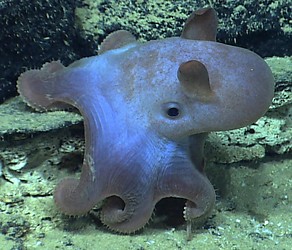


Figure. Three views of the same Grimpoteuthis sp. Left - Starting to move from sitting on the ocean floor. Middle - Lifting off the bottom and beginning to swim. Right - Swimming well off the bottom. Images from NOAA's Ocean Exploration program; frame grabs from video recorded by ROV operated from R/V OKEANOS EXPLORER.
Preservation
Species of Grimpoteuthis, as with many other species of cirrates undergo great shrinkage with fixation and preservation. The cirrate on the left, identified as G. wuelkeri by Uwe Piatkowski, was photographed directly after its capture. The photograph of the same specimen, on the right, was taken after two years in ethanol. While the relative sizes of the two have not been maintained here, note that the eyes and fins appear relatively larger after preservation.
References
Collins, M. A. In press. The genus Grimpoteuthis (Octopoda: Grimpoteuthidae) in the North-east Atlantic, with descriptions of three new species.
Ebersbach, A. 1915. Zur Anatomie von Cirroteuhtis umbellata Fischer und Stauroteuthis sp. Z. Wiss. Zool., 113:361-483.
O’Shea, Steve. 1999. The Marine Fauna of New Zealand: Octopoda (Mollusca: Cephalopoda). NIWA Biodiversity Memoir 112: 280pp.
Robson, G. C. (1932). A monograph of the Recent Cephalopoda. Part II. The Octopoda (excluding the Octopodinae). Brit. Mus. (Nat. Hist.), London.
Villanueva, R. 1992. Continuous spawning in the cirrate octopods Opisthoteuthis agassizii and O. vossi: features of sexual maturation defining a reproductive strategy in cephalopods. Marine Biology, 114:265-275.
Voss, G. L. and W. G. Pearcy. 1990. Deep-water octopods (Mollusca: Cephalopoda) of the Northeastern Pacific. Proc. Calif. Acad. Sci. 47: 47-94.
Young, R. E., M. Vecchione and D. Donovan. 1998. The evolution of coleoid cephalopods and their present biodiversity and ecology. South African Jour. Mar. Sci.., 20: 393-420.
Title Illustrations

| Scientific Name | Grimpoteuthis sp. |
|---|---|
| Location | Antarctic waters |
| Creator | E. McSweeny |
| Copyright | © E. McSweeny |
About This Page

University of Hawaii, Honolulu, HI, USA

National Museum of Natural History, Washington, D. C. , USA
Page copyright © 2016 and
 Page: Tree of Life
Grimpoteuthis .
Authored by
Richard E. Young and Michael Vecchione.
The TEXT of this page is licensed under the
Creative Commons Attribution-NonCommercial License - Version 3.0. Note that images and other media
featured on this page are each governed by their own license, and they may or may not be available
for reuse. Click on an image or a media link to access the media data window, which provides the
relevant licensing information. For the general terms and conditions of ToL material reuse and
redistribution, please see the Tree of Life Copyright
Policies.
Page: Tree of Life
Grimpoteuthis .
Authored by
Richard E. Young and Michael Vecchione.
The TEXT of this page is licensed under the
Creative Commons Attribution-NonCommercial License - Version 3.0. Note that images and other media
featured on this page are each governed by their own license, and they may or may not be available
for reuse. Click on an image or a media link to access the media data window, which provides the
relevant licensing information. For the general terms and conditions of ToL material reuse and
redistribution, please see the Tree of Life Copyright
Policies.
- Content changed 27 February 2016
Citing this page:
Young, Richard E. and Michael Vecchione. 2016. Grimpoteuthis . Version 27 February 2016 (under construction). http://tolweb.org/Grimpoteuthis/20104/2016.02.27 in The Tree of Life Web Project, http://tolweb.org/







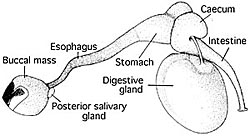


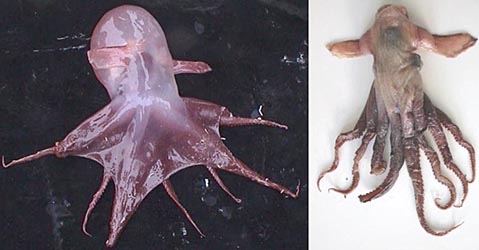



 Go to quick links
Go to quick search
Go to navigation for this section of the ToL site
Go to detailed links for the ToL site
Go to quick links
Go to quick search
Go to navigation for this section of the ToL site
Go to detailed links for the ToL site